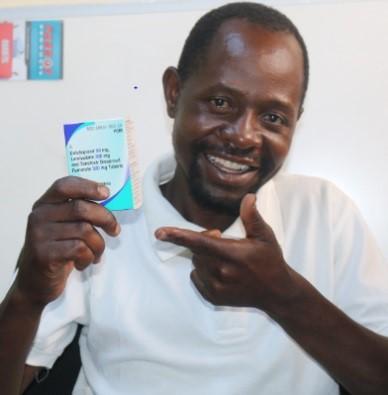Nzima did not yet know it, but he was one of an estimated 1.2 million people living with HIV (PLHIV) in Zambia. In October 2018, concerned family members encouraged the 36-year-old father of two girls to get tested. Nzima tested positive for HIV and was placed on the latest, most effective antiretroviral (ARV) regimen—tenofovir, lamivudine, and dolutegravir (TLD). He has shared his story to encourage his community members to be tested and know their status.
In Zambia, more than 900,000 PLHIV like Nzima access ARVs with the support of the U.S. President’s Emergency Plan for AIDS Relief (PEPFAR) through the USAID Global Health Supply Chain Program-Procurement and Supply Management (GHSC-PSM) project. Most of these patients take tenofovir, lamivudine, and efavirenz (TLE), Zambia’s most commonly used ARV regimen for adults and adolescents. With guidance from the World Health Organization (WHO) and other global health partners, this began to change in June 2018. It was then that the Zambian Ministry of Health (MOH) introduced TLD, a new regimen with a smaller tablet with fewer side effects; this is now considered the preferred first-line regimen.
Ensuring a smooth transition to the new regimen, TLD, required significant planning on the part of many stakeholders to make the necessary changes and mitigate potential risks such as stockouts, overstocks, or wastage of new and former regimens at all levels of the supply chain. Preventing treatment interruption for PLHIV was the primary concern. In July, GHSC-PSM and other partners began working with the MOH to start procuring TLD and transitioning patients to the new regimen.
A year ago, Harrison Nzima was so ill he couldn’t work and lost his job. His weight loss, diarrhea, and extreme bodily weakness were symptoms from infections and a compromised immune system.
What is TLD?
Like TLE, TLD is a fixed-dose combination medication—three ARV drugs that clients take once a day for treatment of HIV/AIDS, but in the form of a single, smaller tablet. TLD is now considered the preferred first-line ARV regimen for adults and adolescents. Generally, it replaces TLE as it has been shown to cause fewer side effects and can suppress HIV viral load within 15 days.

However, following TLD’s introduction, WHO raised concerns over preliminary studies from Botswana that showed there may be increased risk of neural tube defects in babies born to women on TLD. This would have to be considered in guidance given to health providers and when making calculations for the TLE drawdown—TLE stock would still need to be on hand for pregnant women if they did not switch to TLD.
To develop a robust and thoughtful transition strategy, the MOH formed a TLD Steering Committee. The committee convened donors, implementing partners and agencies including Medical Stores Limited (MSL), the U.S. Centers for Disease Control and Prevention (CDC), GHSC-PSM, EQUIP Health, Catholic Relief Services (CRS), University of Maryland-Baltimore, Centre for Infectious Diseases and Research in Zambia (CIDRZ), Clinton Health Access Initiative (CHAI), Churches Health Association of Zambia (CHAZ) and other civil society organizations. These entities contributed policy, clinical, and supply chain expertise to Zambia’s TLD transition strategy.
The TLD Steering Committee developed and published a TLD prescribing algorithm to help health workers determine a patient's eligibility for TLD, which includes factors such as a person's weight, viral load, and whether they are of child-bearing age if female. As an active member of the TLD Steering Committee, GHSC-PSM analyzed the TLD pipeline, provided technical assistance and advised on the impact of scale-up of available commodities and expected shipments.
GHSC-PSM also worked closely with the MOH and other stakeholders to address concerns about the possible increased risk of birth defects for pregnant women on TLD. With new guidance released after widescale transition to TLD began, WHO emphasized that women and adolescents of child-bearing age will need to make informed choices. It is therefore critical that TLD is used alongside consistent and reliable contraception or other voluntary family planning methods that must be available in HIV clinics. This guidance has led to lower patient uptake of TLD and has slowed some orders to avoid overstock.
In early 2019, 62 percent of health centers and hospitals had transitioned to TLD, with more than 126,000 patients now using TLD. The MOH and its implementing partners are conducting periodic reviews of patient and logistics data to inform and update regimen transition guidelines.
GHSC-PSM, on behalf of PEPFAR, has delivered 3.78 million bottles of TLD to Zambia at a cost of nearly $24 million since the transition began in 2018.